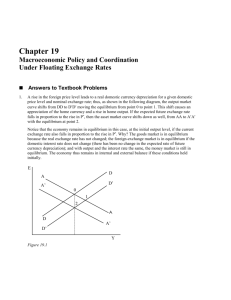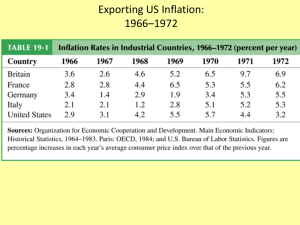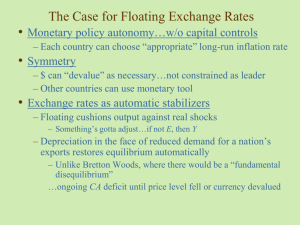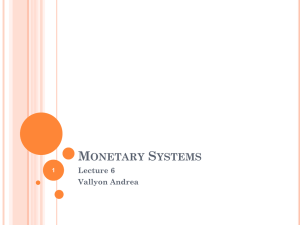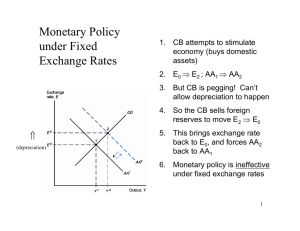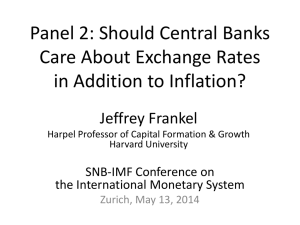chapter 19
advertisement
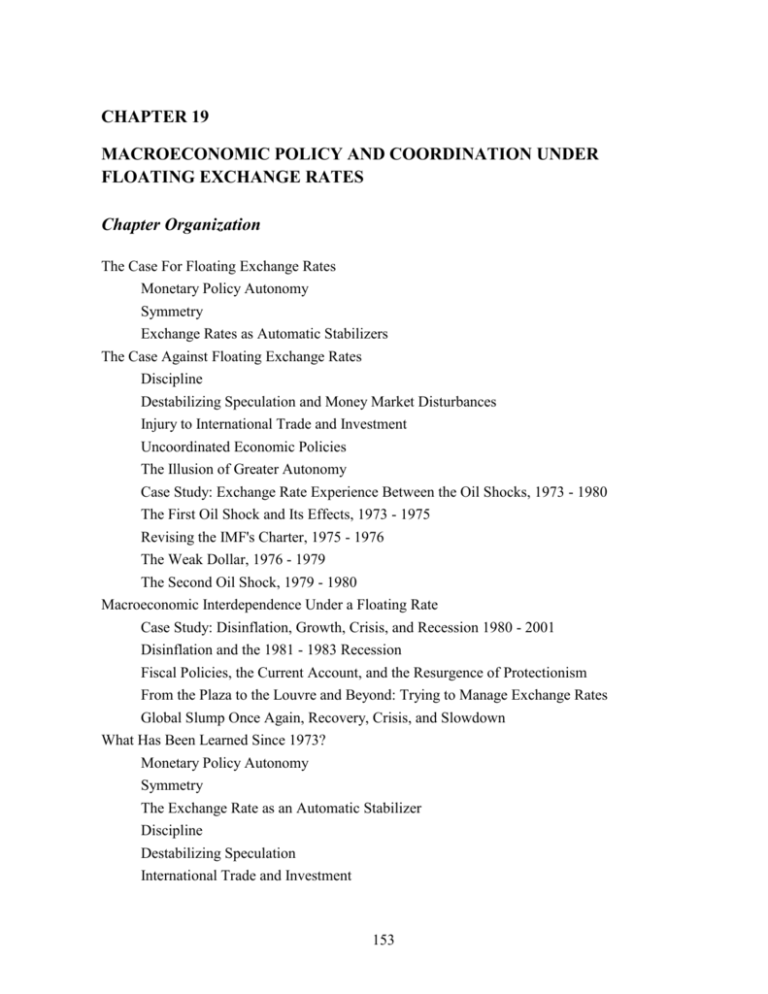
CHAPTER 19 MACROECONOMIC POLICY AND COORDINATION UNDER FLOATING EXCHANGE RATES Chapter Organization The Case For Floating Exchange Rates Monetary Policy Autonomy Symmetry Exchange Rates as Automatic Stabilizers The Case Against Floating Exchange Rates Discipline Destabilizing Speculation and Money Market Disturbances Injury to International Trade and Investment Uncoordinated Economic Policies The Illusion of Greater Autonomy Case Study: Exchange Rate Experience Between the Oil Shocks, 1973 - 1980 The First Oil Shock and Its Effects, 1973 - 1975 Revising the IMF's Charter, 1975 - 1976 The Weak Dollar, 1976 - 1979 The Second Oil Shock, 1979 - 1980 Macroeconomic Interdependence Under a Floating Rate Case Study: Disinflation, Growth, Crisis, and Recession 1980 - 2001 Disinflation and the 1981 - 1983 Recession Fiscal Policies, the Current Account, and the Resurgence of Protectionism From the Plaza to the Louvre and Beyond: Trying to Manage Exchange Rates Global Slump Once Again, Recovery, Crisis, and Slowdown What Has Been Learned Since 1973? Monetary Policy Autonomy Symmetry The Exchange Rate as an Automatic Stabilizer Discipline Destabilizing Speculation International Trade and Investment 153 Policy Coordination Are Fixed Exchange Rates Even an Option for Most Countries ? Directions for Reform Summary Appendix: International Policy-Coordination Failures CHAPTER OVERVIEW The floating exchange rate system in place since 1973 was not, in contrast with the Bretton Woods system, well planned before its inception. Instead, it has developed as an ad hoc system, muddling through the various shocks with which the world economy has had to contend. Disillusion with economic performance since 1973 has often fueled demands for alternative international monetary arrangements. This chapter sets forth the case for and against floating exchange rates and considers the evidence concerning the performance of the international exchange-rate system since 1973. A set of theoretical arguments for and against floating exchange rates frame the discussion of this chapter. Proponents of a floating exchange rate regime cite as its advantages the autonomy it gives to monetary policy, the symmetry of adjustment under floating, and the automatic stabilization which floating rates provide when aggregate-demand shocks occur. Critics fault floating rates on the grounds that they do not impose enough discipline on governments or promote economic policy coordination, because of alleged detrimental effects on international trade and investment, and because floating exchange rates may be susceptible to harmful destabilizing speculation. The DD-AA model first presented in Chapter 16 is used to demonstrate that money-market shocks are less disruptive under a fixed exchange-rate regime than under a floating regime while output-market shocks are less disruptive under a floating exchange rate regime. This result is important in considering the relative attractiveness of floating exchange rates in face of the first oil shock in 1973. This shock led to "stagflation," simultaneous recession and inflation. It is unlikely that a fixed-exchange-rate system would have survived without widespread realignments and speculative attacks. Industrial countries chose expansionary macro policies and recovery from the recession of 1974 was underway in most of these countries by the first half of 1975. The success with which the floating-exchange-rate regime allowed countries to adjust to the first oil shock prompted a call by the leaders of the main industrial countries for the IMF to formally recognize the new arrangement. The IMF 154 directors heeded this by amending the Fund's Articles of Agreement to recognize the new reality of floating rates. Floating exchange rates enabled countries to pursue divergent expansionary policies after the first oil shock. This advantage of floating exchange rates proved to be a disadvantage as the recovery of 1974-1975 turned into the slowdown of 1976. American policies more expansionary than those pursued by Germany and Japan weakened the dollar, pushed the U.S. current account into deficit, and contributed to a resurgence of inflation in the United States. The second oil shock promoted fears of higher inflation, leading to restrictive monetary policies that plunged the world economy, in 1981, into the deepest recession since the Great Depression. This chapter also discusses the way in which two large countries’ economies affect one another, examining the global effects of fiscal and monetary policy in the 1980s and 1990s. This discussion incorporates feedback effects from policy in one economy to economic performance in the other. A fiscal expansion in either country increases output in both countries. A monetary expansion in the domestic country, however, raises domestic output but, by making the foreign currency more expensive, lowers foreign output. In the text, the ideas are used to analyze the effects of U.S. monetary and fiscal policy after 1980, particularly the Volcker disinflation and the Reagan fiscal expansion. The impact of the resulting dollar appreciation on world current accounts and on protectionist sentiment in the United States are also discussed. In the face of growing protectionist pressure in the United States, economic officials of the Group of Five (G-5) countries met at the Plaza Hotel in New York in September 1985 where they agreed to intervene jointly in the foreign-exchange market to bring about a dollar depreciation. This marked a reversal from the United States' laissez-faire approach to dollar management in the first half of the 1980s. The dollar depreciated throughout 1986. In February 1987, at a meeting at the Louvre, finance ministers and central bankers from the G5 countries plus Canada set up (unpublished) target zones to stabilize exchange rates around their then-current level. Currencies stabilized for several months thereafter, but this period of quiescence ended with the October 1987 stock market crash which began a period of further dollar depreciation. Despite a brief theoretical maintenance of zones, by the early 1990s, zones had been abandoned. After a period of slow growth in many nations around 1990, the United States has experienced a long expansion. Alternatively, by 1999, Japan had not fully 155 recovered from the end of its asset bubble in the early 1990s. This has affected the other Asian countries, a topic returned to in Chapter 22. Conclusions concerning the advantages of floating exchange rates are not unambiguous. The insulation of economies from inflation, while important in the long run, may not hold in the short run. The exchange rate's role as a macroeconomic target also reduces the autonomy central banks actually enjoy under floating rates. Evidence does not support the "vicious circle" theory that, in the absence of accommodating monetary policy, currency depreciation leads to inflation, leading to further depreciation, and so on. Nor is there convincing evidence that floating rates have hindered international trade and investment. Lack of policy coordination has been a particularly disappointing feature of the system, but this problem is not unique to floating rates. The chapter also considers the emerging view that durable fixed exchange rates may not be possible, even if they were more desirable than floating rates, unless a single currency is created. These arguments rest on theories of speculative attacks, the problems of the policy trilemma, and the recent experiences in developing countries. A lesson that emerges from this chapter is that no exchange rate system works well when countries act on the basis of narrowly-perceived self interest. The chapter appendix illustrates this point, using a simple game-theoretic example to show how the beggar-thy-neighbor effects of monetary restriction can lead to uncoordinated macroeconomic policies that make two countries worse off than they would be if they cooperated. ANSWERS TO TEXTBOOK PROBLEMS 1. A rise in the foreign price level leads to a real domestic currency depreciation for a given domestic price level and nominal exchange rate; thus, as shown in the following diagram, the output market curve shifts from DD to D'D' moving the equilibrium from point 0 to point 1. This shift causes an appreciation of the home currency and a rise in home output. If the expected future exchange rate falls in proportion to the rise in P*, then the asset market curve shifts down as well, from AA to A'A' with the equilibrium at point 2. Notice that the economy remains in equilibrium in this case, at the initial output level, if the current exchange rate also falls in proportion to the rise in P*. Why? The goods market is in equilibrium because the real exchange rate has not changed; the foreignexchange market is in equilibrium if the domestic interest rate does not change (there has been no change in the expected rate of future currency depreciation); and with 156 output and the interest rate the same, the money market is still in equilibrium. The economy thus remains in internal and external balance if these conditions held initially. E D A D’ A’ 0 1 2 A D A’ D’ Y Figure 19-1 2. A transitory increase in the foreign interest rate shifts the asset market curve up and to the right from AA to A'A', as shown in the figure 19-2 (there is no change in the expected exchange rate since this is a temporary rise). Under a floating exchange rate there is thus a depreciation of the home currency and an increase in output. (The effect could differ in the IS-LM model, where the real interest rate influences aggregate demand directly; the DD curve would shift up and to the right as well.) Under a fixed exchange rate, however, the monetary authority must intervene to prevent the depreciation, so it contracts the home money supply by selling foreign exchange and drives the home interest rate to the new higher world level. This causes AA to return to its original position, leaving output unaffected. (Once again, the result would differ in the IS-LM model since foreign interest-rate shocks are not pure money-market disturbances in that model.) 3. The effect of a permanent rise in the foreign nominal interest rate depends upon whether that rise is due to an increase in inflationary expectations abroad or a rise in the foreign real interest rate. If the foreign real interest rate rises because of monetary contraction abroad, there is a long-run depreciation of the domestic currency which reinforces the depreciation that occurs in problem 2. The expansionary effect on home 157 output is thus greater than in the transitory case. If the foreign nominal interest rate rises only because foreign inflationary expectations rise, however, the expectations effect goes the other way and the long-run expected price of foreign currency falls, shifting AA to the left. Domestic output need not rise in this case. Under a fixed exchange rate there is still no short run effect on the economy in the DD-AA model, but as P* starts to rise the home country will have to import foreign inflation. Under a floating rate the home economy can be completely insulated from the subsequent foreign inflation. E D A’ A A’ D A Y Figure 19-2 4. A rise in foreign inflation could arise from a permanent increase in foreign monetary growth. This causes the home currency to appreciate against the foreign currency, implying also a real appreciation (since P and P* are fixed in the short run). Domestic output therefore falls as foreign output rises. In the long run, relative PPP implies that the rate of domestic currency appreciation rises to offset the higher foreign inflation. The foreign nominal interest rate rises by the increase in expected inflation (the Fisher effect); the domestic nominal interest rate is the same as its initial long-run value; and by relative PPP, interest parity continues to hold. Notice that in this case, the expected future exchange rate moves over time to reflect the trend inflation differential. 5. We can include the aspect of imperfect asset substitutability in the DD-AA model by recognizing that the AA schedule now must equate M/P=L(R*+ expected depreciation + risk premium, Y). An increase in the risk premium shifts out the AA curve, leading 158 to a currency depreciation and an increase in output. Output will not change under a fixed-exchange-rate regime: since the exchange rate parity must be preserved, there will be no depreciation and no effect on output. 6. In Chapter 18 there is an analysis of internal and external balance for fixed exchange rates. It is possible to construct a corresponding diagram for floating exchange rates. In figure 19-4, the vertical axis measures expansion of the money supply and the horizontal axis measures fiscal ease. The internal balance curve II has a negative slope since monetary restraint must be met by greater fiscal expansion to preserve internal balance. The external balance curve XX has a positive slope since monetary expansion, which depreciates the exchange rate and improves the current account, must be matched by fiscal expansion to preserve external balance. The "four zones of economic discomfort" are : Zone 1 -- overemployment and excessive current account surplus; Zone 2 -- overemployment and current account deficit; Zone 3 -- underemployment and current account deficit; Zone 4 -- underemployment and current account surplus. X I 1 Money Supply Growth 4 2 3 0 I X Fiscal Ease Figure 19-4 7. The diagram described in the answer to question 6 can be used to answer this question. The United States begins at point 0 after 1985, where it is in internal balance but there is a large current account deficit. In the short run, monetary expansion (an upward shift in the point) moves the economy toward the goal of a greater current account surplus, 159 but also moves the economy out of internal balance toward overemployment. The expenditure-reducing policy of reducing the budget deficit (represented by a leftward shift in the point), used in tandem with an expenditure-switching monetary expansion, can restore external balance while maintaining internal balance. Moving the economy into a zone of overemployment puts pressure on the price level which ultimately reverses the short-run effect of monetary expansion on the real exchange rate. 8. Fiscal expansion in Germany and Japan would have appreciated the currencies of those countries and diminished the bilateral U.S. trade deficits with them, as desired by American officials. On the other hand, monetary expansion in these countries would have worsened the U.S. current account since the dollar would have appreciated relative to the deutschemark and the yen. Our two-country models suggests that U.S. output would have fallen as a result. These effects would differ, of course, if the United States altered its policies in response to policy changes in Germany or Japan. For example, if the United States expanded its money supply with the expansion in either Germany or Japan there would be no bilateral effects. If the United States contracted fiscal policy as Germany or Japan expanded fiscal policy there would less of an effect on output in each country. 9. Sterilized intervention has no effect on the supply of high-powered money. A way to check whether the intervention in connection with the Louvre accord in February 1987 was sterilized is to see if there are unusual movements in German or Japanese stocks of high-powered money around that time. The International Financial Statistics, published by the IMF, includes measures of reserve money (line 14). These data, for Germany (in billions of DM at end of month) and Japan (in billions of yen at end of month), are as follows: Month/Yr. 10/86 Japan Germany 26,318 169.6 11/86 12/86 1/87 2/87 3/87 4/87 5/87 27,772 32,119 27,844 29,016 30,146 29,998 29,379 179.3 182.9 169.8 178.3 193.3 180.5 192.8 These data for Japan reflect a more-or-less steady trend in high-powered money. The largest deviations from this trend do not occur around February 1987. The highpowered money series for Germany appears less stable. There is a substantial increase between the end of January 1987 and the end of March 1987, an increase that was somewhat reversed by the end of April, but rose again by the end of May 1987. 160 10. One can construct a matrix analogous to figure 19A-1 in the text to show the change in inflation and the change in exports for each country in response to monetary policy choices by that country and by the other country. Export growth in a country will be greater, but inflation will be higher, if that country undertakes a more expansionary monetary policy, given the other country's policy choice. There is, however, a beggarthy- neighbor effect because one country's greater export growth implies lower export growth for the other. Without policy coordination, the two countries will adopt overexpansionary monetary policies to improve their competitive positions, but these policies will offset each other and result simply in higher inflation everywhere. With coordination, the countries will realize that they can both enjoy lower inflation if they agree not to engage in competitive currency depreciation. FURTHER READINGS Ralph C. Bryant International Coordination of National Stabilization Policies. Washington, D.C.: Brookings Institution, 1995. Richard H. Clarida. G-3 Exchange-Rate Relationships: A Review of the Record and Proposals for Change. Princeton Essays in International Economics 219. International Economics Section, Department of Economics, Princeton University. September 2000. Martin S. Feldstein. "Distinguished Lecture on Economics in Government: Thinking about International Economic Coordination." Journal of Economic Perspectives 2 (Spring 1989), pp. 3 - 13. Milton Friedman. "The Case for Flexible Exchange Rates," in Essays in Positive Economics. Chicago: University of Chicago Press, 1953, pp. 157-203. Morris Goldstein. The Exchange Rate System and the IMF: A Modest Agenda. Policy Analyses in International Economics 39. Washington, D.C.: Institute for International Economics, 1995. Harry G. Johnson. "The Case for Flexible Exchange Rates, 1969," Federal Reserve Bank of St. Louis Review, 51 (June 1969), pp. 12-24. Charles P. Kindleberger. "The Case for Fixed Exchange Rates, 1969," in The International Adjustment Mechanism, Conference Series 2. Boston: Federal Reserve Bank of Boston, 1970, pp. 93-108. 161 Michael Mussa. "Macroeconomic Interdependence and the Exchange Rate Regime," in Rudiger Dornbusch and Jacob A. Frenkel, eds., International Economic Policy. Baltimore: Johns Hopkins University Press, 1979, pp. 160-204. Maurice Obstfeld. "International Currency Experience: New Lessons and Lessons Relearned." Brookings Papers on Economic Activity (1:1995), pp. 119-220. Robert Solomon. The International Monetary System, 1945-1981. New York: Harper & Row, 1982. Robert Solomon. Money on the Move: The Revolution in International Finance since 1980. Princeton, NJ: Princeton University Press, 1999. John Williamson. The Exchange Rate System, 2nd edition. Policy Analyses in International Economics 5. Washington, D.C.: Institute for International Economics, 1985. 162
